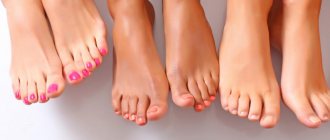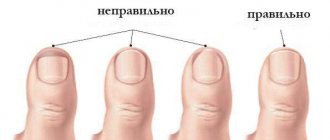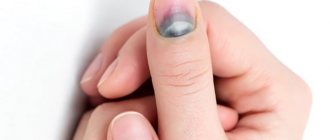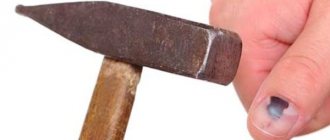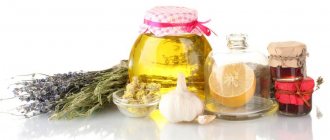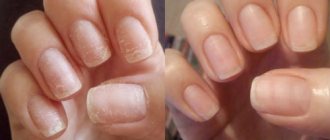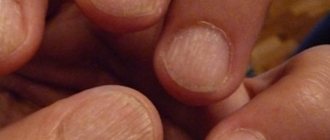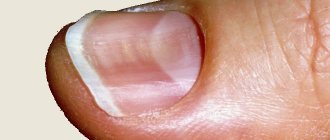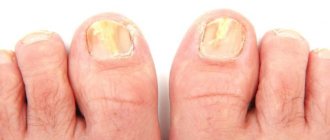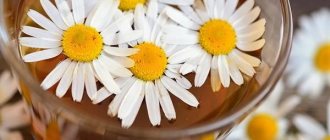Causes of thickening toenails
The health of nails depends on the condition of the human body, but their thickening cannot be associated with an aesthetic defect. It is often seen on the legs rather than the arms. Thickening of the nail plates is associated with impaired blood circulation in the toes, which leads to a deterioration in metabolism. Useful components no longer reach the lower extremities in sufficient quantities.
Causes of thickening toenails
People suffering from polykeratosis experience discomfort due to thickened nails. The disease, transmitted by inheritance, is associated with excess keratin in the body. As a result, there is not only a change in the color of the nails, which turn yellow, but also an increase in their thickness.
Physiological reasons
Injury can be considered the most common physiological cause of nail damage. The defect can be discovered after wearing someone else's or tight shoes. When working with formaldehyde, pedicurists or specialists in other fields expose their body to a metabolic disorder that causes thickening of nails.
The problem also arises when constantly working with aggressive compounds:
- fertilizers;
- chemicals;
- detergents;
- solvents.
The defect may be associated with poor nutrition or exhausting diets due to anemia caused by insufficient protein intake in the body. The problem may arise due to low intake of calcium and iron in foods. Damage to toenails occurs in people who wear rough shoes.
Socks that are larger than necessary can disrupt metabolism and cause deterioration of the nail plate. An incorrectly done pedicure or constant abuse of varnish coatings causes thickening of the toenails.
It is important to constantly monitor the health of your nails and consume trace elements, vitamins and minerals in sufficient quantities. This will increase the body's immune defense. It is necessary to get rid of bad habits in a timely manner, since nicotine in the body of smokers has a detrimental effect on the legs.
Pathological causes
Thickening of toenails, the causes of which are often associated with gout, rheumatism or atherosclerosis, requires timely treatment. If the nail plate is short, the disease may be caused by micronychia. The pathology occurs in people who suffer from the bad habit of biting their nails; its development can be accompanied by trophoneurosis and genuine epilepsy.
Leukonychia
White stripes and spots appear on thickened nails, which are a symptom of leukonychia. An arcuate stripe on the surface of the nail plate is a disease called cross-striation of the nails.
Among the characteristic causes of pathology are the presence of the following types of diseases:
- inflammation;
- infections;
- eczema;
- psoriasis;
- oncology;
- measles or scarlet fever in childhood;
- neuropsychiatric disorders.
The pathology is caused by dermatological diseases, which are autoimmune diseases, including psoriasis, the consequences of which can be severe. The disease can be caused by radiation or chemotherapy for oncology, as a result of which the Hippocrates nail symptom can be observed.
It is also associated with other types of diseases:
- tuberculosis;
- leukemia;
- cirrhosis of the liver;
- lichen planus;
- cancer of the esophagus, lungs, thyroid gland;
- cardiovascular diseases;
- intestinal inflammation.
Onychomycosis can cause changes in the appearance of the nail associated with the appearance of spots, grooves, and growths. The nail plates begin to soften, flake and crumble if the disease is advanced. At the same time, the feet sweat a lot, an unpleasant odor emanates from them, and the person feels constant itching. Infection of healthy toes with fungus can occur due to trying on someone else's shoes or poor hygiene.
Causes of thickening
Doctors explain why nails curl and thicken. All this is due to a systemic disease of the body with viruses, onychomycosis or injury. For these reasons, the nail may become layered, hard, and curved. The plates on the legs are most often damaged, but the arms can also be affected.
Mechanical damage to the nail plate
Tight and uncomfortable shoes lead to damage to the nail and disruption of its normal growth. The surface of the plate is regularly injured, it begins to intensively regenerate, forming a thick protective layer.
There is nowhere to grow forward due to tight shoes, so the nail grows upward and becomes noticeably thicker. It turns yellow, with an uneven surface that may be covered with cracks. The nail on the little toe most often becomes thicker due to shoes that are too small.
Obstructed blood flow in the extremities also leads to deformation of the nail plates. They change shape, become hard and compacted due to injury, inflammatory disease of the fingers or nail bed. Even an unsuccessful pedicure can lead to such a cosmetic defect. Flat feet or club feet also cause deformation and thickening of the nail.
Diseases
Thick toenails most often occur due to fungal diseases, which affect every fourth person. Onychomycosis or fungus develops unnoticed at first. The patient usually notices signs of the disease in the later stages. Treating fungus is not easy and takes a lot of time. You should consult a doctor if the following symptoms appear:
- the thickness of the nails increases, their color changes;
- the plate is covered with cracks and begins to peel off;
- white or yellow spots appear;
- an unpleasant odor occurs;
- the skin on the feet, especially in the interdigital area, peels and is very itchy;
- If you smear an iodine solution on the affected nail, dark spots will appear on it with onychomycosis.
A fungal infection can be easily distinguished from a traumatic nail hardening by looking at the photo. With mycosis, the nail crumbles, and in advanced cases, peeling and yellowing may appear.
Methods for diagnosing the problem
Thickening of toenails, the causes of which lead to increased elasticity of the nail plate and looseness of the skin at its base, requires timely medical diagnosis. A specialist in the field of dermatology not only performs palpation and visual inspection, but also conducts a detailed study of the structure of the affected nail.
The initial stage of diagnosis involves the prevention of traumatic factors. If the cause of the patient’s illness is associated with pathology, then its severity may vary.
An in-depth diagnostic study performed by a podologist or mycologist allows one to exclude or confirm the presence of a particular disease. The doctor should examine the patient's legs using a lighted magnifying glass. This will allow you to study the color, shape and type of edges of the nail plate.
Among the main research methods carried out by specialists are:
- scraping for microscopic analysis (culture for onychomycosis);
- general and biochemical blood test (for microelements);
- spectral analysis of the nail plate;
- chest x-ray (if tuberculosis, pneumonia, or various lung diseases are suspected).
To identify many types of diseases, complex diagnostics is needed. This will allow you to prescribe the right course of treatment, the effectiveness of which depends on the patient’s compliance with the doctor’s requirements.
Treatment
A dry nail plate is dangerous because the cracks that appear on it deepen over time and serve as a real gateway for fungal infections and bacteria. Once the condition of the hands is neglected, the skin and nails will imperceptibly reach a bleeding, painful state. With 99% confidence, we can say that you will need a course of taking vitamin-mineral complexes with a high content of vitamins A, E, D. If the problem was caught at the beginning, then perhaps you can saturate the body with vitamins using food. Vegetables and fruits, fish and beef liver, bread with bran and cereal sprouts should be added to the diet. The use of cosmetic moisturizers and home remedies from available substances helps to cope with dryness of the nails and the skin around them.
Folk
Baths, masks and hand care creams can be bought in pharmacies, beauty salons or made from improvised products.
Baths
If your nails become thin and begin to peel, a bath of regular table salt will help. You need to add a little salt to warm water and hold your hands for about 15 minutes. Salt kills infections and promotes the accumulation of moisture. Baths made from medicinal plants and essential oils are good for disinfecting nail plates and moisturizing the skin:
- Chamomile decoction;
- Oak bark decoction;
- Tea tree oil;
- Decoction of potatoes with the addition of a few drops of vegetable oil.
The temperature of the healing liquid should be comfortable for the hands. After the procedure, wash your hands with warm water and lubricate with nourishing cream.
Masks
Often, after cooking, pieces of boiled and fresh vegetables and fruits remain. This waste can be successfully used to nourish the nails and skin of the hands. Just mash a piece of vegetable, add vegetable oil and apply to your hands. Keep the mask for 10-15 minutes and rinse with warm water. Blue clay is considered an excellent product for cosmetic masks. They can be used no more than once a week. Dilute a spoonful of clay powder with warm water and add a few drops of olive oil. If there are microcracks, it is recommended to add a couple of drops of pharmaceutical iodine or tea tree oil. This will help further protect the nail from fungal infection. You can keep the mask on your hands for no more than 30 minutes. After this, rinse with warm water and apply nourishing cream to your hands.
Wax masks at night do an excellent job of exfoliating the nail plates and nourishing the skin around them. They can also be used to treat dry toenails. Heat the beeswax in a water bath, add half a teaspoon of honey or a little salt. Dip your fingers into the melted wax for a few seconds and let cool. Wear soft gloves (wear socks when treating feet). Apply the mask throughout the night no more than once every three days. In the morning, just wash off the mask with very warm water. Hand care is quite simple and does not take much time. Alternating treatments will help prevent dryness problems.
Types of drugs for the treatment of toenails: names, release forms, advantages and disadvantages
It is important for a dermatologist to know whether this disease has occurred in the past, experience and duration of treatment. The choice of medication depends on the type of causative agent of the disease, which must be determined during diagnosis. The active component of each drug is capable of treating a specific infection. Under the influence of yeast or mold fungi, the nail plate thickens.
Local varieties of medications for the treatment of nail diseases are used externally. The systemic category includes drugs in the form of tablets or capsules used for oral administration and taken orally. They are effective if local drugs can no longer cure an advanced disease.
Ointments
Highly active ointments operate on the principle of the greenhouse effect created when the ointment is applied to the affected area. The film formed by the ointment prevents the penetration of oxygen to the area affected by the pathogen, causing its death. Lamisil and Mikozan ointments operate on this principle.
Lamisil
The advantage of using Lamisil is associated with the action of an active substance called terbinafine. The ointment is effective against fungal infections; it does not cause negative reactions. The disadvantage of using the drug is the absence of any studies related to the prescription of the drug to pregnant women.
Mikozan ointment is easy to apply because the tube contains an applicator brush. The package contains disposable files. The advantage of the drug can be considered the presence in the set with the ointment of a diary for recording a schedule of procedures and a template that allows you to control the color of the nail.
Sprays
The drug Lamisil, manufactured in Switzerland on the basis of terbinafine, is effective against onychomycosis. The product eliminates dermatophytes, yeast and mold fungi, preventing their proliferation. The therapeutic effect of the aerosol drug is associated with the elimination of itching and inflammation. The duration of treatment is 7 days when using the spray once daily.
A budget product made in Russia can be considered a Bifosin spray based on befonazole, which is effective for the treatment of all known types of fungus. The duration of treatment with the drug is 2-4 weeks. The aerosol should be used once a day.
Bifosin
The German spray Canesten has a positive effect in the treatment of foot fungus. The destruction of the structure of the fungus occurs under the influence of the substance Clotrimazole. The treatment course should last 2-4 weeks with daily single use of the spray.
Lucky
Any product in the form of medicinal varnish should be used after reading the instructions for it.
The main advantages of these drugs for the treatment of mycosis with a liquid structure are as follows:
- ease of application;
- deep penetration;
- filling microcracks;
- quick drying;
- durable coating.
For effective treatment with one drug or another, it is important to follow the therapeutic regimen given in the table.
Nail polishes effective against fungus:
| Name | Active ingredient | Treatment regimen | Well | Cost, rub.) |
| Batrafen | ciclopirox | every other day at 1 month; 2 times a week at 2 months; 1 time per week every 3 months. | 6 months | 2200 |
| Demicten | formic acid aldehyde | 1 time daily | 1 month | 230 |
| Lamisil | terbinafine | 2 times per week | 6-12 months | 1300 |
| Lotseril | amorolfine | 1 or 2 times a week | 6-12 months | 1300 |
| Mikozan | Rye enzyme filtrate | 2 times a day | 4 weeks | 860 |
| Oflomelid | amorolfine | 1 or 2 times a week | until complete recovery | 900 |
Instructions for use of the drug:
- Wash your feet with laundry soap and wipe them dry.
- Degrease your nails using a cotton swab soaked in alcohol.
- Trim your nails as short as possible, removing loose particles using an individual nail file for all nail plates.
- Apply the varnish and wait 30 seconds until it dries completely. up to 3 min.
Varnish is prescribed if no more than 60% of the nail area is infected. Side effects include itching, redness of the skin, and burning.
Oral preparations
Systemic therapy based on oral medications involves the ingestion of antifungal tablets. Many types of oral agents are ineffective against onychomycosis. They can prevent the proliferation of fungus, having a fungistatic effect.
These include toxic drugs in the form of tablets or oral suspensions Griseofulvin and Fulcin. The duration of treatment for toenails is 9-18 months. The drugs are contraindicated during pregnancy, blood diseases, and should not be used by children.
Nizoral
The following oral medications are effective against onychomycosis , which partially or completely eliminate yeast, molds and dermatophytes that affect toenails, replacing topical drugs:
- Ketoconazole - duration of treatment course is 8-12 months;
- Nizoral - treatment duration 6 months;
- Itraconazole - toenail therapy includes 3 courses with a break of 3 weeks;
- Terbinafine - course of treatment of toenails for 12 weeks;
- Lamisil - course duration is from 1.5 to 3 months.
Drugs in the form of tablets of 125 mg, 200 mg or 250 g are contraindicated for liver or kidney diseases. Nausea, dizziness, vomiting are side effects from taking the drugs. They may have a negative effect on appetite. If a negative reaction occurs in the body, you should stop taking these medications and consult your doctor.
Antifungal treatment
The presence of infection often causes thickening of the nails. It can be eliminated through complex treatment using medications and folk remedies.
Medicines prescribed by a dermatologist for the treatment of pathology may be as follows:
- Lamisil;
- Mikozan;
- Terbizil;
- Mifungar;
- Betrafen.
They should be taken with great caution. This will avoid side effects, since antifungal medications can negatively affect the condition of the kidneys and liver. The product should be used according to the instructions and prescriptions of the doctor.
Treatment of fungal nail diseases
Many people, initially, do not take fungal diseases seriously and do not pay attention to them. At the same time, the disease progresses and it becomes more and more difficult to treat.
You need to know that parasites are constantly mutating and changing. They adapted to existing antibiotics.
It’s scary that bacteria and microorganisms are ahead of humans in their development, turning into monsters from horror films. Billions of these microscopic monsters literally claim a person’s life in a matter of days. They are difficult to cure. The impact on them should be long-term (continuous, most often) for several months and complex.
Fungal diseases can affect both internal and external organs of a person, initially causing discomfort, and subsequently pain, colossal discomfort and even death. The disease is insidious.
Skin and nail fungus, like other parasites, love an environment where it is warm and damp.
You can become infected with them in swimming pools; gyms, where they use a shared shower or rent shoes (ski boots, skates); in public spaces where it is necessary to take off shoes, in the absence of shoe covers or replacement shoes.
If the body’s immunity is weakened, then the fungus can “stick” to the feet in the warm season, when it is hot and pleasant to walk barefoot.
The nail fungus onychomycosis causes many problems. It can be determined by the following characteristics:
- external defects arise - for example, waves; There is abnormal growth in the other direction, the shape of the nail is distorted;
- A light or yellowish spot appears on the nail plate. It is increasing. May become darker or greener;
- when pressed, aching pain occurs and constant discomfort appears;
- The structure of the nail plate is deformed: it becomes fragile, begins to crumble, and delaminates. Unpleasant yellow growths may form, causing pain and making it difficult to walk;
- cracks and severe itching between the toes and on the feet, resulting from drying out of the skin by the fungus.
In all of the above cases, you must first consult a podiatrist who treats foot diseases. After this, begin a comprehensive treatment of toenail fungus, which will be quite long.
If there are significant changes, a course of treatment with internal and local medications is necessary. The latter must be used regularly and for a long time - until the diseased nail is completely replaced with a healthy one.
Treatment with ointments can last up to six months. Patience and regular procedures are required.
Of the internal medications, the most effective are orungal, fluconazole, itraconazole (for fungi of yeast origin), ketoconazole (a drug that accumulates in tissues for a stable effect on fungal infections in severe forms: mycosis and others).
Effective topical preparations are called fungicides. Penetrating into the nail, they destroy the fungus. The most effective old and new: demicten, mycosan, batrafen, loteryl, clotrimazole, naftifine, terbinafine others.
Post-traumatic therapy
For a thickened nail, the cause of which is associated with a leg injury, it is important to reduce the load. If the injured area does not allow you to walk normally, it is better not to leave the house for several days. Otherwise, you need to apply a patch to the damaged nail and wear open-toed shoes. Recinol can be used to treat infected areas.
Recinol
The active component of the product has anti-inflammatory and anesthetic effects. Recinol restores tissue structures, which speeds up the healing process. An injured nail can be treated with medication, using ointment or gel. Troxevasin, heparin ointments, and arnica are suitable. Treatment of the nail plate should be performed several times a day for about a week.
What problems does hardware cosmetology treat?
Therapeutic pedicure based on hardware cleaning is effective before applying medication to the damaged nail plate. Modern methods of treating diseased nails in cosmetology involve the use of a basic pedicure machine with different types of tools, ranging from blades and cutters to wire cutters.
Nail treatment occurs under the influence of a nozzle, which the device rotates. It is effective in the most advanced cases. Removing the damaged layer of the nail plate facilitates the penetration of antimycotic drugs into its structure.
Hardware cosmetology
The procedure is painless, which is an advantage of hardware nail treatment, which does not take much time. Cleaning with a pedicure device is not dangerous for patients diagnosed with diabetes, eczema or an allergic reaction. It increases the effectiveness of fungal treatment by almost 95%.
Indications
The method of hardware cleaning is effective in cases of onychomycosis, when it is necessary to remove the nail damaged by the fungus. The method improves the treatment of nail plates infected with fungus with various drugs, including ointments, varnishes or sprays.
It allows you to collect as much biological tissue as possible, ensuring an accurate diagnosis during laboratory tests.
The device has no side effects and is safe to use. The method allows you to prevent complications resulting from fungal infection. Hardware pedicure improves the appearance of damaged nail plates.
Contraindications
Various injuries to the skin of the feet or open wounds on the legs are contraindications for treatment using hardware. This universal method should be excluded in case of dermatoses or possible allergic reactions, as well as neoplasms.
Cleaning the nail plates using hardware is not recommended for pregnant women. The method is contraindicated for patients suffering from liver and kidney diseases. In any case, it is necessary to consult a specialist before using hardware cosmetology as a method of treating mycosis.
How the procedures are carried out, duration of treatment
Hardware cleaning of infected toenail plates is based on the use of a standard set of materials and a special composition for disinfection, ethanol and peroxide. The kit should include a drug that softens the nail plate. The procedure requires the use of special clothing by a healthcare worker.
From the inventory you need to take a foot bath, finger spreaders, and napkins. The choice of cleaning technique depends on the diagnosis.
A medical professional performing a pedicure procedure using a hardware method must perform the following steps step by step:
- Examine the foot and nail plates to diagnose the patient’s condition.
- Disinfect the skin of your toes and feet using the composition included in the kit.
- Treat the cuticle of each nail with a special oil to soften its structure.
- Immerse the patient's feet in an antiseptic composition to soften the skin.
- Treat the nail plates using a device and special attachments with cutters.
- Remove corns and calluses from the soles of your feet.
- Perform a foot peeling and scrubbing procedure.
After treating the nails and feet with the device, you can apply an antifungal agent and perform a special massage to improve blood circulation. Further treatment will depend on the patient's conscientious compliance with all instructions of the attending dermatologist. The cost of processing one finger using hardware is on average about 150 rubles.
Folk remedies for thickening nails. Recipes and regimens
The pathology associated with thickened nails can be cured using folk remedies, for the preparation of which various medicinal herbs are used. The composition of these products does not have a harmful effect on the kidneys and liver, and the treatment itself rarely causes allergies. Using the prepared product, you can make a foot bath or compress.
Foot bath
Recipes for folk remedies may involve combining different plants that are beneficial to the body or using individual types of herbs. The phytotherapeutic effect can be expected within 2-12 weeks. Medicinal herbs are especially useful in cases with advanced disease.
Apple vinegar
To treat onychomycosis or an infectious fungal infection of the body, you can use products based on apple cider vinegar. An acidic environment can eliminate pathogenic parasitic infections that affect the circulatory and lymphatic systems.
You can treat your feet and toenails in the following ways:
- Cut 4 kg of washed and peeled apples into 4 parts.
- Grind the slices in a blender or meat grinder.
- Squeeze out the pulp from the apples through several layers of gauze.
- Pour the juice into a 3 liter container, adding boiled water and 2 g of dry yeast.
- Add 50 g of granulated sugar, pour in 1 liter of vinegar 9%, mix the composition.
- Put a medical glove on the neck of the bottle with liquid and place the product in a dark place for 2 weeks.
Homemade apple cider vinegar, free of chemicals, can be added to water intended for foot baths. The product is contraindicated if there are fresh lesions on the skin of the feet, for example, in the form of calluses. If necessary, the product can be diluted with water in a ratio of 2:1. The antiseptic effect of acid causes the destruction of fungus on the feet.
Birch buds
To make your own tincture on birch buds at home, you should prepare 1/2 tbsp. birch raw materials. The composition allows you to make effective compresses that soften toenails. It is enough to take 1/2 liter of vodka and infuse birch buds in it for 10 to 12 days, placing the container in a dark place.
Birch buds
The prepared composition can be wiped over the affected nail plates to soften them. You can rub your feet with the tincture and make compresses on them. After the procedure, the affected area can be insulated by wrapping it with film. If necessary, the softened nail should be carefully removed so that a new one can grow in its place.
Herbal decoctions and infusions
Thickening of toenails, the causes of which are associated with mycosis, can be cured using decoctions and tinctures of medicinal plants. They are useful at any stage of the development of the disease due to their complex effect on the body.
An infusion can be prepared by adding vodka or ethyl alcohol to a container with chopped herbs:
- mint;
- wormwood;
- sequences;
- sage;
- thyme;
- nettle;
- celandine;
- golden mustache
During the preparation process, the infusion must undergo heat treatment using water. The composition will be completely ready in 45 minutes. after cooling. The herbal decoction can be prepared by boiling for 20-25 minutes.
Herbal decoctions and infusions
You can prepare a decoction from the roots of the following plant species:
- calamus;
- burdock;
- celandine;
- Canadian goldenseal.
To prepare a decoction of calamus root, pour 15 g of the product into 0.3 liters of boiling water, after crushing the plant.
You need to cook the mixture for 5-10 minutes. on low heat. Drink the cooled liquid 3 times a day for a month, 15 ml. Goldenseal juice containing the natural antibiotic substance berberine allows you to prepare the product in the form of a decoction that has an antimycotic effect.
You need to prepare step by step:
- Take dried goldenseal (2 tsp).
- Pour 200 ml boiling water.
- Leave for about 4 hours.
- Drink the decoction every 6 hours, 2 tsp.
The duration of treatment with a decoction of the root depends on the recommendations of the attending dermatologist.
Therapy with herbal decoctions taken orally can be considered the most effective. Medicinal plants in most cases have immunostimulating and fungicidal effects. Tea from 1 tsp is useful. horsetail, brewed 1 tbsp. boiling water You can cure a fungal disease with this drink within 2 weeks.
Herbal decoctions and infusions
Tea from 4 tbsp helps. mixtures of the following types of herbs:
- sage;
- sagebrush;
- plantain;
- yarrow;
- Golden mustache.
Before drinking, the drink must be steamed, placed in a water bath, and then drunk within 24 hours, divided into 8 servings. The product is effective not only in the treatment of nail fungus, but also for overall health promotion. It is useful to prevent complications of the disease using tea with the addition of honey and cinnamon, 1 tsp each.
Doctors recommend a medicinal decoction of Echinacea, which you should drink for 10 days. After completing the course, you need to rest for 7 days and then continue again. Additionally useful is the use of walnuts, from which you can make lotions or use them as jam.
Celandine juice
A remedy that kills foot fungus can be prepared from the herb celandine. After grinding the grass and flowers of the plant in a meat grinder or blender, you need to squeeze the juice out of them through gauze folded in several layers. Treatment should be carried out with an alcohol-based product of 70% or more.
Juice mixed with alcohol in a 1:1 ratio should be used to treat the damaged area on the leg every day. The nail plate must first be cleaned.
The solution must be applied 1-2 times a day. The duration of treatment is 2 weeks. Advanced disease can be treated within 4 weeks. Celandine juice is suitable for compresses. Keep the composition on the fungus-affected area for at least 30 minutes. This will ensure timely supply of oxygen to the damaged nail.
Lemon
The bactericidal effect of lemon on the body in most cases allows you to cure fungal diseases that cause thickening of toenails. Citrus is effective against microorganisms and is characterized by an anti-inflammatory effect.
Description of the procedure for preparing the lemon composition and treating it step by step:
- Squeeze juice from lemon (1 pc.) or take citric acid.
- Mix juice with vinegar (1 tbsp) and 2.5 tbsp. warm water.
- Take baths for 10 minutes. or treat infected skin areas with the product.
- Repeat the procedure every day until the damaged nail is removed and a healthy nail plate appears.
Lemon
Not only lemon juice, but also the peel can be used for therapeutic purposes. Before the treatment procedure, you should disinfect the skin of your feet by adding a little soda or salt to the water. To soften the skin when exposed to lemon juice, you can use baby cream.
The problem can be eliminated using daily lotions, carried out 2 times a day. To do this, apply a cotton swab soaked in freshly squeezed lemon juice to the affected area of the leg. After drying, the cotton wool should be removed and put on warm socks.
To make it easier to trim the affected nail, you can mix soda paste and 10 drops of lemon juice. After laying a layer of the mixture on the affected area, you must leave it for no more than 15 minutes. After removing the composition, you need to wash your feet with soapy water.
Iodine
To eliminate thickening of toenails, iodine baths are useful. Add 3 drops each of tea tree oil and iodine to warm water. Soak your feet in the solution for 10 minutes. The course of treatment consists of daily repetitions of the procedure. Treatment of affected areas on the legs with tincture of alcohol provides a positive effect of treatment.
Iodine baths
To do this, make compresses from a mixture of 1 tbsp. apple cider vinegar and 3 drops of water. You can mix lemon juice with iodine and soda, dissolving it in warm water for baths. To apply a solution with added iodine, the alcohol tincture can be applied using a sterile swab or cotton swab. The product has an antiseptic, cauterizing and anti-inflammatory effect.
Complex therapy for thickened nails infected with a fungal disease requires regular foot hygiene to completely eliminate the cause of the disease during the procedures. Local or systemic medications can be prescribed along with folk remedies for more effective treatment.
Treating nails at home
It is advisable to begin self-treatment of the toenail plate at home only after the correct diagnosis has been established and medical recommendations have been received. The use of traditional medicines will be an effective addition to drug treatment and will allow you to recover faster.
- Liniment. Iodine and vinegar should be mixed in equal parts and the affected areas should be lubricated with the resulting mixture every day. It is convenient to use a cotton swab for application. The procedure must be carried out until the thickening goes away.
- Compress of iodinol and celandine. Iodinol must be mixed with a couple of teaspoons of celandine. The consistency of the resulting mixture should be similar to gruel. Apply the product and leave for about forty minutes. The procedure must be repeated within a week. This folk method is suitable if your toenails grow slowly. By the end of the treatment, you will see that the new plate is growing healthy.
- Lemon compress. Thinly sliced lemon slices should be applied to the affected surface and secured with a bandage or cellophane film. It is advisable to wear warm socks and leave the compress on overnight. The procedure must be done every day for one and a half weeks. Gradually the plate will become thinner.
- Vinegar bath. An equal amount of vinegar should be diluted in warm water. It is dangerous to mix the liquid poorly or add more vinegar than necessary - there is a danger of getting burned. It is advisable to do such baths before bed, soaking your feet for half an hour to an hour.
- Vinegar-oil compress. You need to mix apple cider vinegar and regular oil in equal proportions. Soak a cotton pad with the resulting liquid and place it on the affected finger so that the cotton wool covers not only the nail, but also the nail fold. You need to securely fix the compress with cellophane film, bandage or plaster, but do not tighten it too much. The compress should be kept for about four hours. The result will be noticeable after five days of daily use.
Perhaps the only exception to the rule will be thickening due to injury. No medication is required here. You just need to wait until the nail grows to normal thickness.
To speed up recovery after injury, it will be useful to take vitamin and mineral complexes. It would be a good idea to include foods rich in healthy elements in your diet – fresh vegetables and fruits. They will help to naturally strengthen the nail and accelerate its growth.
